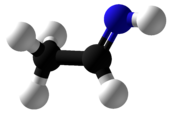Ethanimine

| |||
| |||
| Names | |||
|---|---|---|---|
| Preferred IUPAC name
Ethanimine | |||
| Other names
Ethylidenimine; (Ethylidene)amine; Acetaldehyde imine; Acetaldehyde-ammonia Schiff base; Acetaldimine; Iminoethane
| |||
| Identifiers | |||
3D model (JSmol)
|
|||
| ChemSpider | |||
PubChem CID
|
|||
| |||
| |||
| Properties | |||
| C2H5N | |||
| Molar mass | 43.069 g·mol−1 | ||
Except where otherwise noted, data are given for materials in their standard state (at 25 °C [77 °F], 100 kPa). | |||
| Infobox references | |||
Ethanimine is an organonitrogen compound classified as an imine. It is formed by reacting acetaldehyde and ammonia but rapidly polymerizes to acetaldehyde ammonia trimer. It has two tautomers: ethanimine and aminoethylene, an amine. Ethanimine places the extra hydrogen on the carbon, while aminoethylene has it on the nitrogen atom.
Occurrence[]
It is not well known terrestrially, but has been detected in abundance towards Sagittarius B2 (Sgr B2), a dense interstellar cloud in between stars towards the galactic center of the Milky Way. The distance between the Sgr B2 cloud and center of galaxy is 100 pc (1 pc = 3.26 ly). Ethanimine is mainly found in hot cores of ISM clouds; in case of Sgr B2, the region would be the Sgr B2 N and Sgr B2 M.[1] Radio telescopes such as the Green Bank Observatory's Green Bank Telescope and those operated by the National Radio Astronomy Observatory (measuring radio frequency light lambda ranging from 1–300 GHz) are able to detect organic molecules such as ethanimines because its internal energy transition, more specifically the rotational transition is within the radio frequency of 14085 MHz = 140.8 GHz.[2]
References[]
- ^ Miao, Y., Mehringer, D. M., Kuan, Y.-J., & Snyder, L. E. Complex molecules in Sagittarius B2(N): The importance of grain chemistry. Astrophysical Journal Letters (ISSN 0004-637X), pg 445.
- ^ Danger, J.-B. Bossa1, P. de Marcellus, F. Borget, F. Duvernay, P. Theulé, T. Chiavassa and L. d’Hendecourt. Experimental investigation of nitrile formation from VUV photochemistry of interstellar ices analogs: acetonitrile and amino acetonitrile. A&A Astrochem & Astrophy. Journal 525, Number A30, January 2011.
- Imines
- Astronomy stubs
- Organic compound stubs

